BUS300: McDonald's External Environment Analysis Report - Semester 1
VerifiedAdded on 2022/09/12
|14
|3371
|24
Report
AI Summary
This report provides a comprehensive analysis of McDonald's external environment, focusing on eight key domains: technological, economic, competitive, labour, resource, customer, legal & regulatory, and global environments. It examines how these factors impact McDonald's business strategy and performance, particularly in the Australian market. The analysis includes an overview of the company, its strengths (brand goodwill, social responsiveness), and the challenges it faces, such as intense competition and evolving consumer demands. The report explores the impact of technology, economic fluctuations, and regulatory requirements. It identifies key opportunities, such as technological advancements and expansion into international markets, and threats, including competition and changing consumer preferences. The report concludes with recommendations for McDonald's to maintain its competitive advantage and ensure future growth, including investments in healthy food supplies and adapting to technological changes.
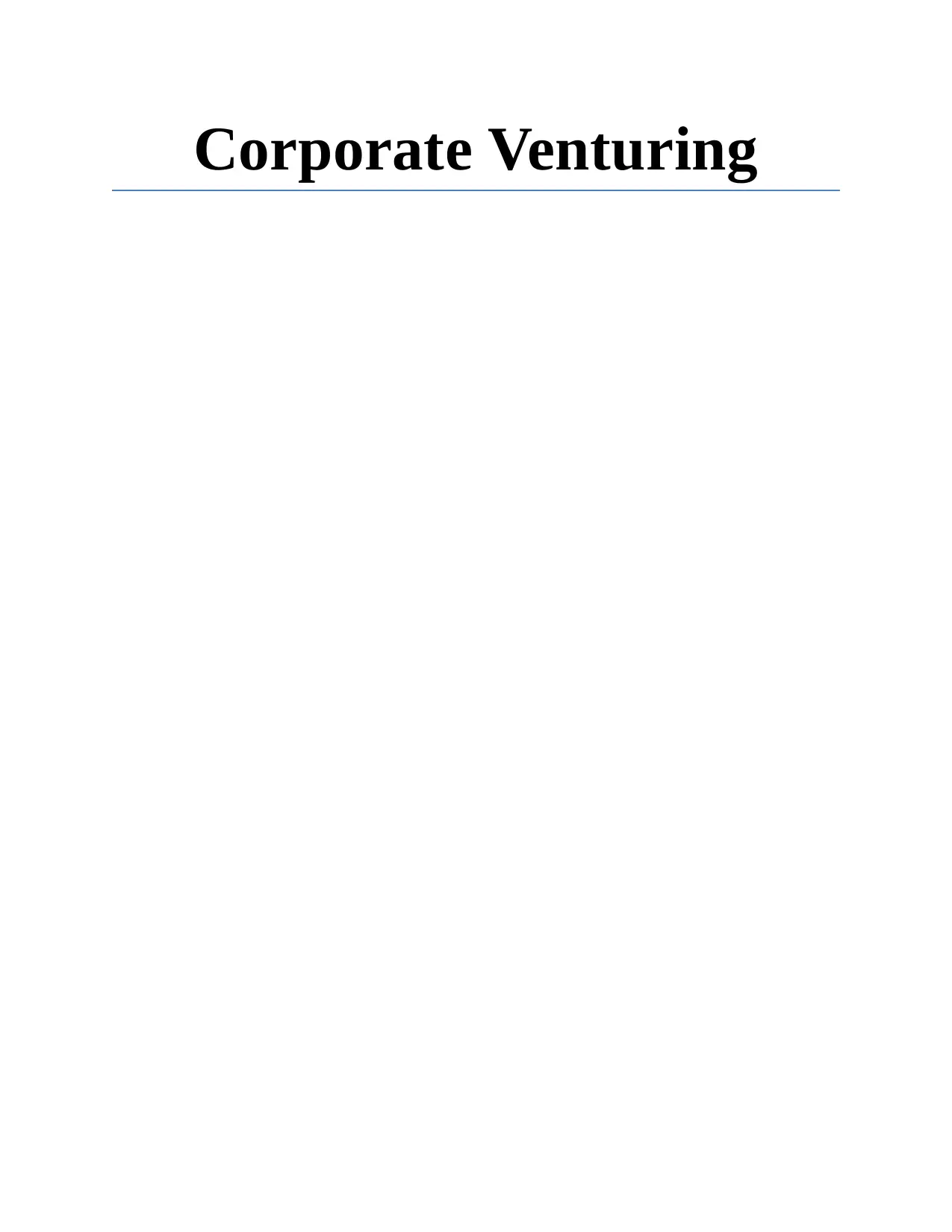
Corporate Venturing
Paraphrase This Document
Need a fresh take? Get an instant paraphrase of this document with our AI Paraphraser
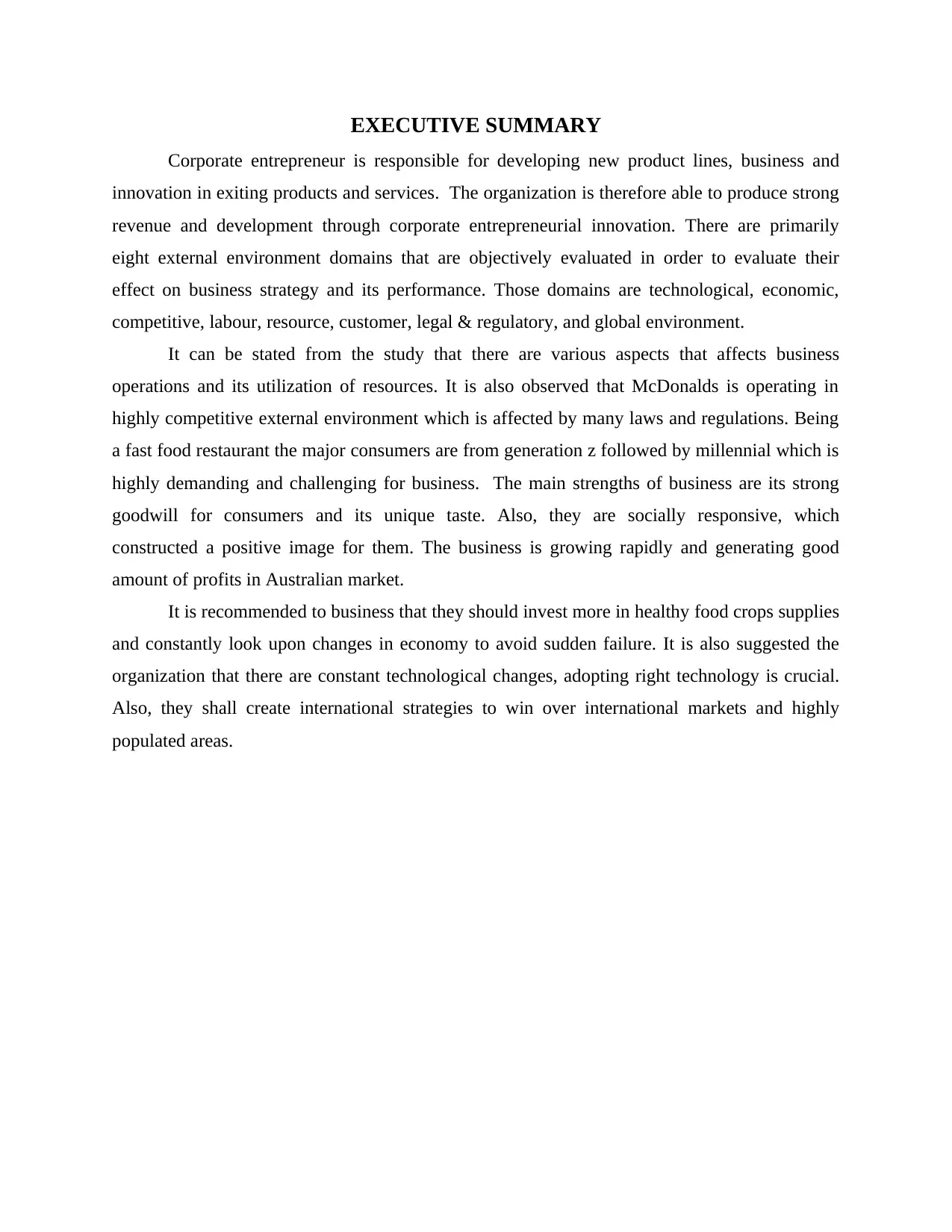
EXECUTIVE SUMMARY
Corporate entrepreneur is responsible for developing new product lines, business and
innovation in exiting products and services. The organization is therefore able to produce strong
revenue and development through corporate entrepreneurial innovation. There are primarily
eight external environment domains that are objectively evaluated in order to evaluate their
effect on business strategy and its performance. Those domains are technological, economic,
competitive, labour, resource, customer, legal & regulatory, and global environment.
It can be stated from the study that there are various aspects that affects business
operations and its utilization of resources. It is also observed that McDonalds is operating in
highly competitive external environment which is affected by many laws and regulations. Being
a fast food restaurant the major consumers are from generation z followed by millennial which is
highly demanding and challenging for business. The main strengths of business are its strong
goodwill for consumers and its unique taste. Also, they are socially responsive, which
constructed a positive image for them. The business is growing rapidly and generating good
amount of profits in Australian market.
It is recommended to business that they should invest more in healthy food crops supplies
and constantly look upon changes in economy to avoid sudden failure. It is also suggested the
organization that there are constant technological changes, adopting right technology is crucial.
Also, they shall create international strategies to win over international markets and highly
populated areas.
Corporate entrepreneur is responsible for developing new product lines, business and
innovation in exiting products and services. The organization is therefore able to produce strong
revenue and development through corporate entrepreneurial innovation. There are primarily
eight external environment domains that are objectively evaluated in order to evaluate their
effect on business strategy and its performance. Those domains are technological, economic,
competitive, labour, resource, customer, legal & regulatory, and global environment.
It can be stated from the study that there are various aspects that affects business
operations and its utilization of resources. It is also observed that McDonalds is operating in
highly competitive external environment which is affected by many laws and regulations. Being
a fast food restaurant the major consumers are from generation z followed by millennial which is
highly demanding and challenging for business. The main strengths of business are its strong
goodwill for consumers and its unique taste. Also, they are socially responsive, which
constructed a positive image for them. The business is growing rapidly and generating good
amount of profits in Australian market.
It is recommended to business that they should invest more in healthy food crops supplies
and constantly look upon changes in economy to avoid sudden failure. It is also suggested the
organization that there are constant technological changes, adopting right technology is crucial.
Also, they shall create international strategies to win over international markets and highly
populated areas.
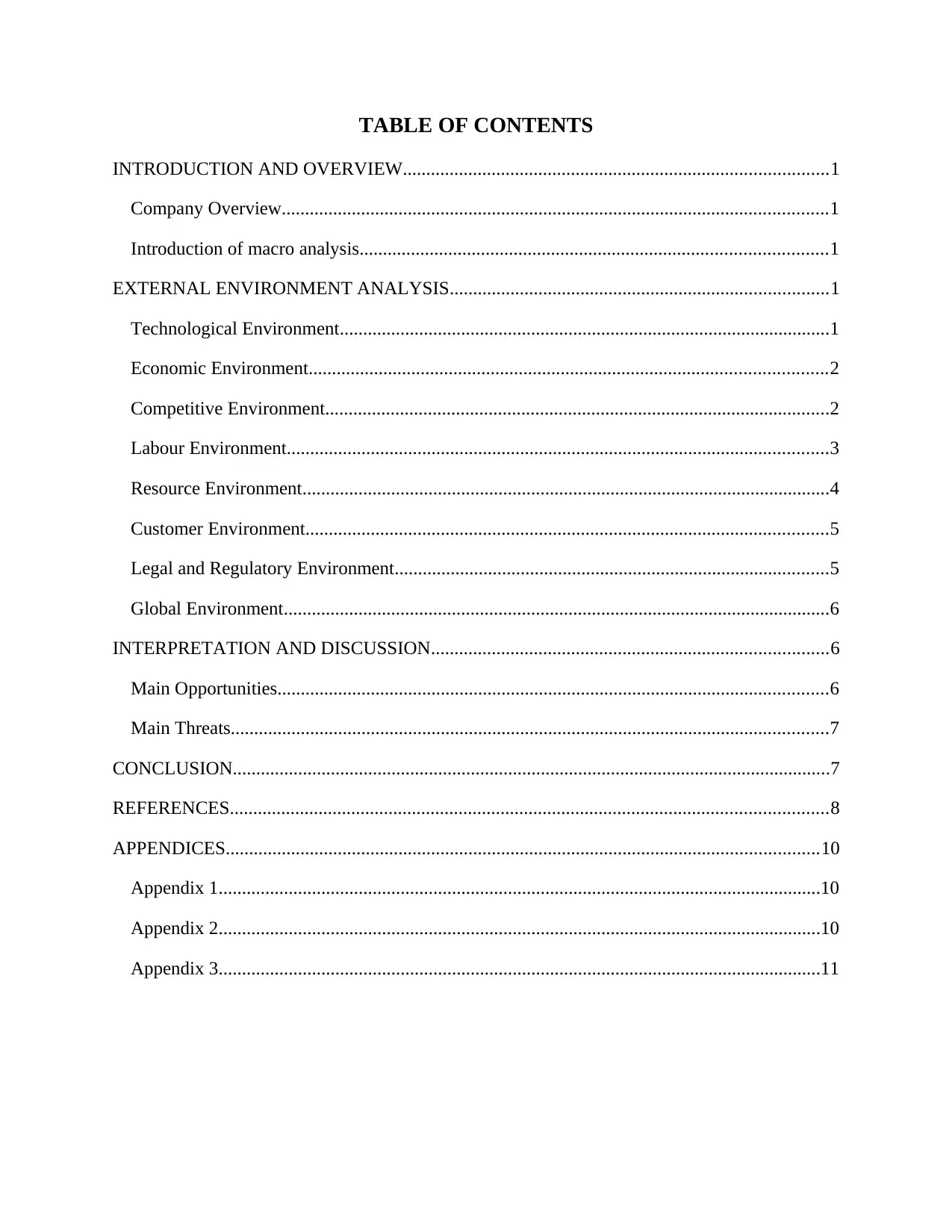
TABLE OF CONTENTS
INTRODUCTION AND OVERVIEW...........................................................................................1
Company Overview.....................................................................................................................1
Introduction of macro analysis....................................................................................................1
EXTERNAL ENVIRONMENT ANALYSIS.................................................................................1
Technological Environment.........................................................................................................1
Economic Environment...............................................................................................................2
Competitive Environment............................................................................................................2
Labour Environment....................................................................................................................3
Resource Environment.................................................................................................................4
Customer Environment................................................................................................................5
Legal and Regulatory Environment.............................................................................................5
Global Environment.....................................................................................................................6
INTERPRETATION AND DISCUSSION.....................................................................................6
Main Opportunities......................................................................................................................6
Main Threats................................................................................................................................7
CONCLUSION................................................................................................................................7
REFERENCES................................................................................................................................8
APPENDICES...............................................................................................................................10
Appendix 1.................................................................................................................................10
Appendix 2.................................................................................................................................10
Appendix 3.................................................................................................................................11
INTRODUCTION AND OVERVIEW...........................................................................................1
Company Overview.....................................................................................................................1
Introduction of macro analysis....................................................................................................1
EXTERNAL ENVIRONMENT ANALYSIS.................................................................................1
Technological Environment.........................................................................................................1
Economic Environment...............................................................................................................2
Competitive Environment............................................................................................................2
Labour Environment....................................................................................................................3
Resource Environment.................................................................................................................4
Customer Environment................................................................................................................5
Legal and Regulatory Environment.............................................................................................5
Global Environment.....................................................................................................................6
INTERPRETATION AND DISCUSSION.....................................................................................6
Main Opportunities......................................................................................................................6
Main Threats................................................................................................................................7
CONCLUSION................................................................................................................................7
REFERENCES................................................................................................................................8
APPENDICES...............................................................................................................................10
Appendix 1.................................................................................................................................10
Appendix 2.................................................................................................................................10
Appendix 3.................................................................................................................................11
⊘ This is a preview!⊘
Do you want full access?
Subscribe today to unlock all pages.

Trusted by 1+ million students worldwide
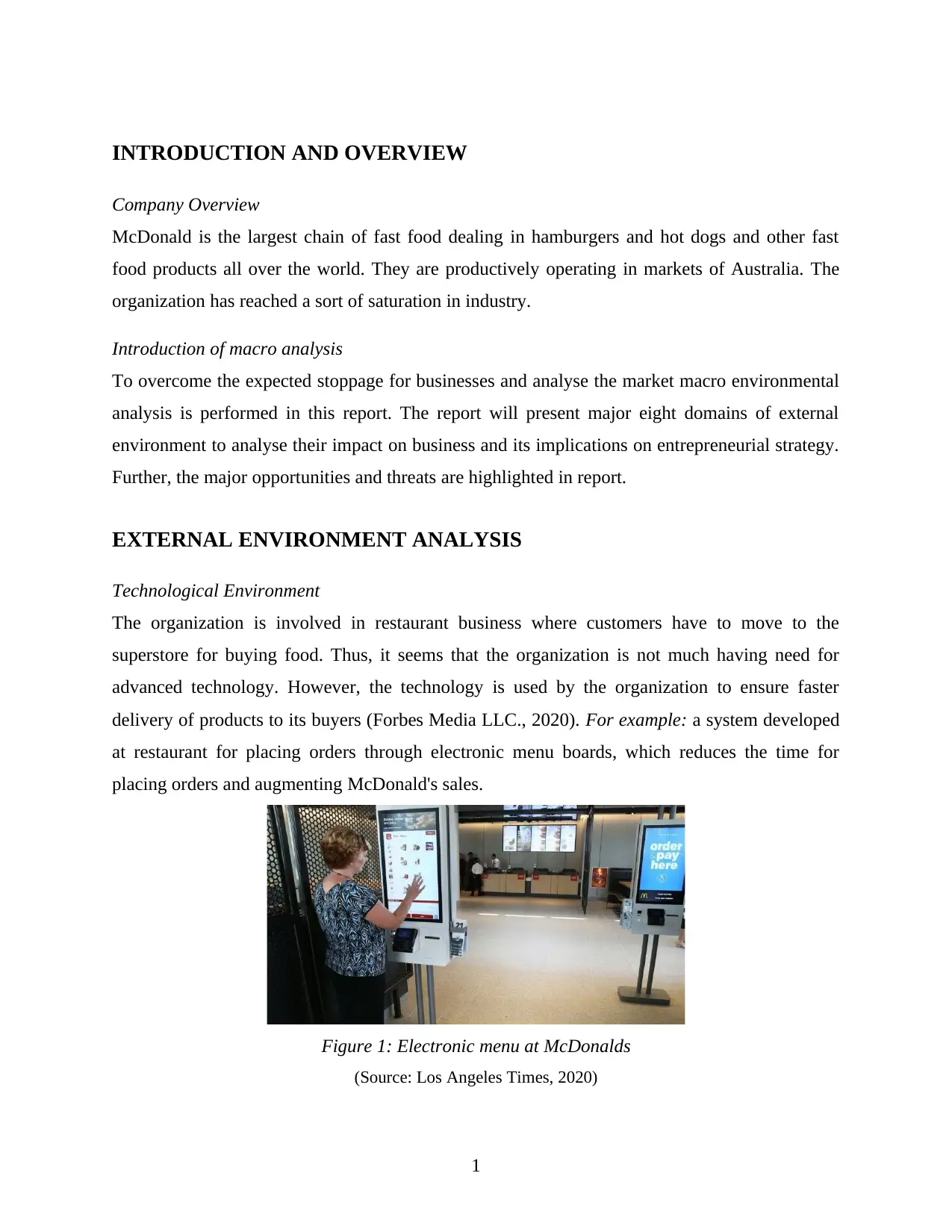
INTRODUCTION AND OVERVIEW
Company Overview
McDonald is the largest chain of fast food dealing in hamburgers and hot dogs and other fast
food products all over the world. They are productively operating in markets of Australia. The
organization has reached a sort of saturation in industry.
Introduction of macro analysis
To overcome the expected stoppage for businesses and analyse the market macro environmental
analysis is performed in this report. The report will present major eight domains of external
environment to analyse their impact on business and its implications on entrepreneurial strategy.
Further, the major opportunities and threats are highlighted in report.
EXTERNAL ENVIRONMENT ANALYSIS
Technological Environment
The organization is involved in restaurant business where customers have to move to the
superstore for buying food. Thus, it seems that the organization is not much having need for
advanced technology. However, the technology is used by the organization to ensure faster
delivery of products to its buyers (Forbes Media LLC., 2020). For example: a system developed
at restaurant for placing orders through electronic menu boards, which reduces the time for
placing orders and augmenting McDonald's sales.
Figure 1: Electronic menu at McDonalds
(Source: Los Angeles Times, 2020)
1
Company Overview
McDonald is the largest chain of fast food dealing in hamburgers and hot dogs and other fast
food products all over the world. They are productively operating in markets of Australia. The
organization has reached a sort of saturation in industry.
Introduction of macro analysis
To overcome the expected stoppage for businesses and analyse the market macro environmental
analysis is performed in this report. The report will present major eight domains of external
environment to analyse their impact on business and its implications on entrepreneurial strategy.
Further, the major opportunities and threats are highlighted in report.
EXTERNAL ENVIRONMENT ANALYSIS
Technological Environment
The organization is involved in restaurant business where customers have to move to the
superstore for buying food. Thus, it seems that the organization is not much having need for
advanced technology. However, the technology is used by the organization to ensure faster
delivery of products to its buyers (Forbes Media LLC., 2020). For example: a system developed
at restaurant for placing orders through electronic menu boards, which reduces the time for
placing orders and augmenting McDonald's sales.
Figure 1: Electronic menu at McDonalds
(Source: Los Angeles Times, 2020)
1
Paraphrase This Document
Need a fresh take? Get an instant paraphrase of this document with our AI Paraphraser
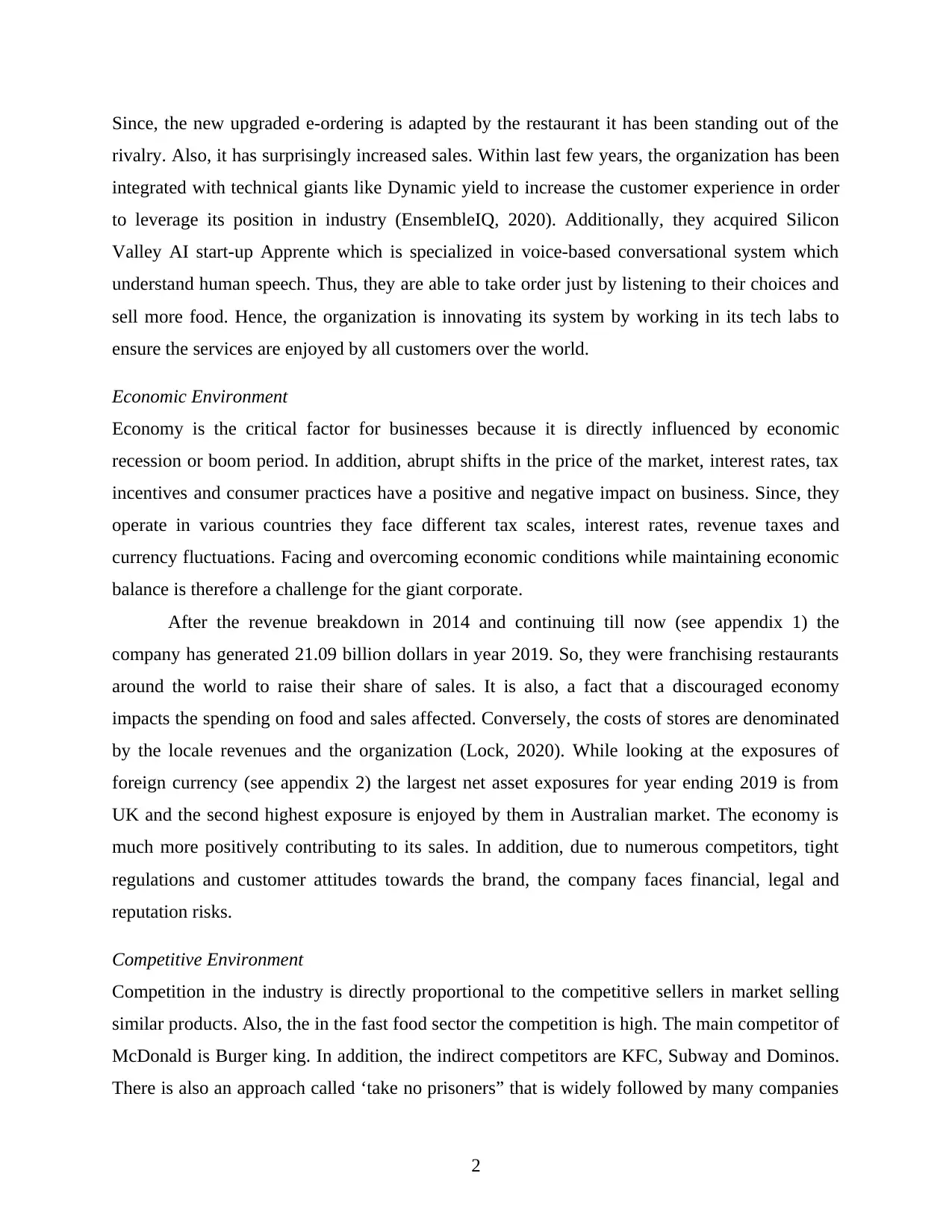
Since, the new upgraded e-ordering is adapted by the restaurant it has been standing out of the
rivalry. Also, it has surprisingly increased sales. Within last few years, the organization has been
integrated with technical giants like Dynamic yield to increase the customer experience in order
to leverage its position in industry (EnsembleIQ, 2020). Additionally, they acquired Silicon
Valley AI start-up Apprente which is specialized in voice-based conversational system which
understand human speech. Thus, they are able to take order just by listening to their choices and
sell more food. Hence, the organization is innovating its system by working in its tech labs to
ensure the services are enjoyed by all customers over the world.
Economic Environment
Economy is the critical factor for businesses because it is directly influenced by economic
recession or boom period. In addition, abrupt shifts in the price of the market, interest rates, tax
incentives and consumer practices have a positive and negative impact on business. Since, they
operate in various countries they face different tax scales, interest rates, revenue taxes and
currency fluctuations. Facing and overcoming economic conditions while maintaining economic
balance is therefore a challenge for the giant corporate.
After the revenue breakdown in 2014 and continuing till now (see appendix 1) the
company has generated 21.09 billion dollars in year 2019. So, they were franchising restaurants
around the world to raise their share of sales. It is also, a fact that a discouraged economy
impacts the spending on food and sales affected. Conversely, the costs of stores are denominated
by the locale revenues and the organization (Lock, 2020). While looking at the exposures of
foreign currency (see appendix 2) the largest net asset exposures for year ending 2019 is from
UK and the second highest exposure is enjoyed by them in Australian market. The economy is
much more positively contributing to its sales. In addition, due to numerous competitors, tight
regulations and customer attitudes towards the brand, the company faces financial, legal and
reputation risks.
Competitive Environment
Competition in the industry is directly proportional to the competitive sellers in market selling
similar products. Also, the in the fast food sector the competition is high. The main competitor of
McDonald is Burger king. In addition, the indirect competitors are KFC, Subway and Dominos.
There is also an approach called ‘take no prisoners” that is widely followed by many companies
2
rivalry. Also, it has surprisingly increased sales. Within last few years, the organization has been
integrated with technical giants like Dynamic yield to increase the customer experience in order
to leverage its position in industry (EnsembleIQ, 2020). Additionally, they acquired Silicon
Valley AI start-up Apprente which is specialized in voice-based conversational system which
understand human speech. Thus, they are able to take order just by listening to their choices and
sell more food. Hence, the organization is innovating its system by working in its tech labs to
ensure the services are enjoyed by all customers over the world.
Economic Environment
Economy is the critical factor for businesses because it is directly influenced by economic
recession or boom period. In addition, abrupt shifts in the price of the market, interest rates, tax
incentives and consumer practices have a positive and negative impact on business. Since, they
operate in various countries they face different tax scales, interest rates, revenue taxes and
currency fluctuations. Facing and overcoming economic conditions while maintaining economic
balance is therefore a challenge for the giant corporate.
After the revenue breakdown in 2014 and continuing till now (see appendix 1) the
company has generated 21.09 billion dollars in year 2019. So, they were franchising restaurants
around the world to raise their share of sales. It is also, a fact that a discouraged economy
impacts the spending on food and sales affected. Conversely, the costs of stores are denominated
by the locale revenues and the organization (Lock, 2020). While looking at the exposures of
foreign currency (see appendix 2) the largest net asset exposures for year ending 2019 is from
UK and the second highest exposure is enjoyed by them in Australian market. The economy is
much more positively contributing to its sales. In addition, due to numerous competitors, tight
regulations and customer attitudes towards the brand, the company faces financial, legal and
reputation risks.
Competitive Environment
Competition in the industry is directly proportional to the competitive sellers in market selling
similar products. Also, the in the fast food sector the competition is high. The main competitor of
McDonald is Burger king. In addition, the indirect competitors are KFC, Subway and Dominos.
There is also an approach called ‘take no prisoners” that is widely followed by many companies
2
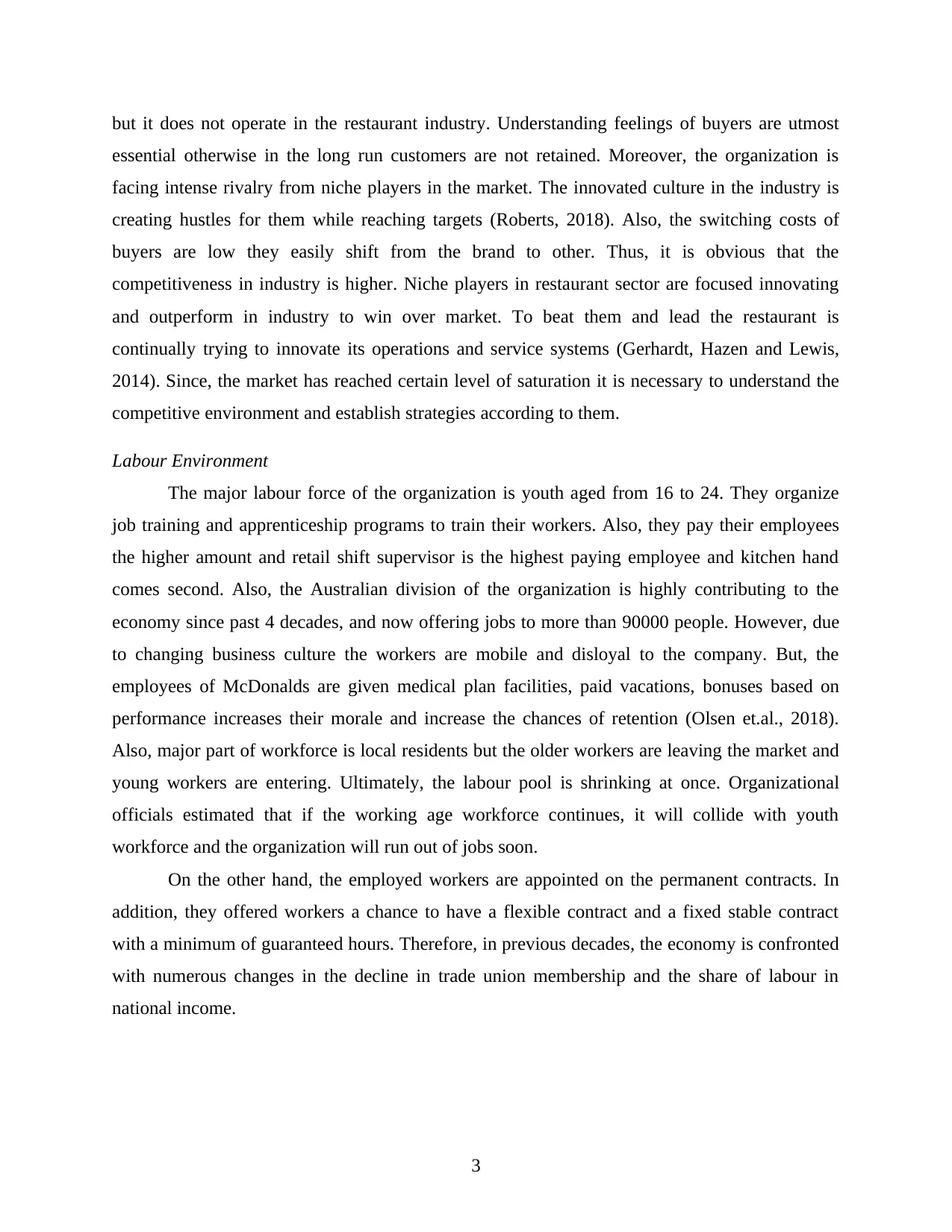
but it does not operate in the restaurant industry. Understanding feelings of buyers are utmost
essential otherwise in the long run customers are not retained. Moreover, the organization is
facing intense rivalry from niche players in the market. The innovated culture in the industry is
creating hustles for them while reaching targets (Roberts, 2018). Also, the switching costs of
buyers are low they easily shift from the brand to other. Thus, it is obvious that the
competitiveness in industry is higher. Niche players in restaurant sector are focused innovating
and outperform in industry to win over market. To beat them and lead the restaurant is
continually trying to innovate its operations and service systems (Gerhardt, Hazen and Lewis,
2014). Since, the market has reached certain level of saturation it is necessary to understand the
competitive environment and establish strategies according to them.
Labour Environment
The major labour force of the organization is youth aged from 16 to 24. They organize
job training and apprenticeship programs to train their workers. Also, they pay their employees
the higher amount and retail shift supervisor is the highest paying employee and kitchen hand
comes second. Also, the Australian division of the organization is highly contributing to the
economy since past 4 decades, and now offering jobs to more than 90000 people. However, due
to changing business culture the workers are mobile and disloyal to the company. But, the
employees of McDonalds are given medical plan facilities, paid vacations, bonuses based on
performance increases their morale and increase the chances of retention (Olsen et.al., 2018).
Also, major part of workforce is local residents but the older workers are leaving the market and
young workers are entering. Ultimately, the labour pool is shrinking at once. Organizational
officials estimated that if the working age workforce continues, it will collide with youth
workforce and the organization will run out of jobs soon.
On the other hand, the employed workers are appointed on the permanent contracts. In
addition, they offered workers a chance to have a flexible contract and a fixed stable contract
with a minimum of guaranteed hours. Therefore, in previous decades, the economy is confronted
with numerous changes in the decline in trade union membership and the share of labour in
national income.
3
essential otherwise in the long run customers are not retained. Moreover, the organization is
facing intense rivalry from niche players in the market. The innovated culture in the industry is
creating hustles for them while reaching targets (Roberts, 2018). Also, the switching costs of
buyers are low they easily shift from the brand to other. Thus, it is obvious that the
competitiveness in industry is higher. Niche players in restaurant sector are focused innovating
and outperform in industry to win over market. To beat them and lead the restaurant is
continually trying to innovate its operations and service systems (Gerhardt, Hazen and Lewis,
2014). Since, the market has reached certain level of saturation it is necessary to understand the
competitive environment and establish strategies according to them.
Labour Environment
The major labour force of the organization is youth aged from 16 to 24. They organize
job training and apprenticeship programs to train their workers. Also, they pay their employees
the higher amount and retail shift supervisor is the highest paying employee and kitchen hand
comes second. Also, the Australian division of the organization is highly contributing to the
economy since past 4 decades, and now offering jobs to more than 90000 people. However, due
to changing business culture the workers are mobile and disloyal to the company. But, the
employees of McDonalds are given medical plan facilities, paid vacations, bonuses based on
performance increases their morale and increase the chances of retention (Olsen et.al., 2018).
Also, major part of workforce is local residents but the older workers are leaving the market and
young workers are entering. Ultimately, the labour pool is shrinking at once. Organizational
officials estimated that if the working age workforce continues, it will collide with youth
workforce and the organization will run out of jobs soon.
On the other hand, the employed workers are appointed on the permanent contracts. In
addition, they offered workers a chance to have a flexible contract and a fixed stable contract
with a minimum of guaranteed hours. Therefore, in previous decades, the economy is confronted
with numerous changes in the decline in trade union membership and the share of labour in
national income.
3
⊘ This is a preview!⊘
Do you want full access?
Subscribe today to unlock all pages.

Trusted by 1+ million students worldwide
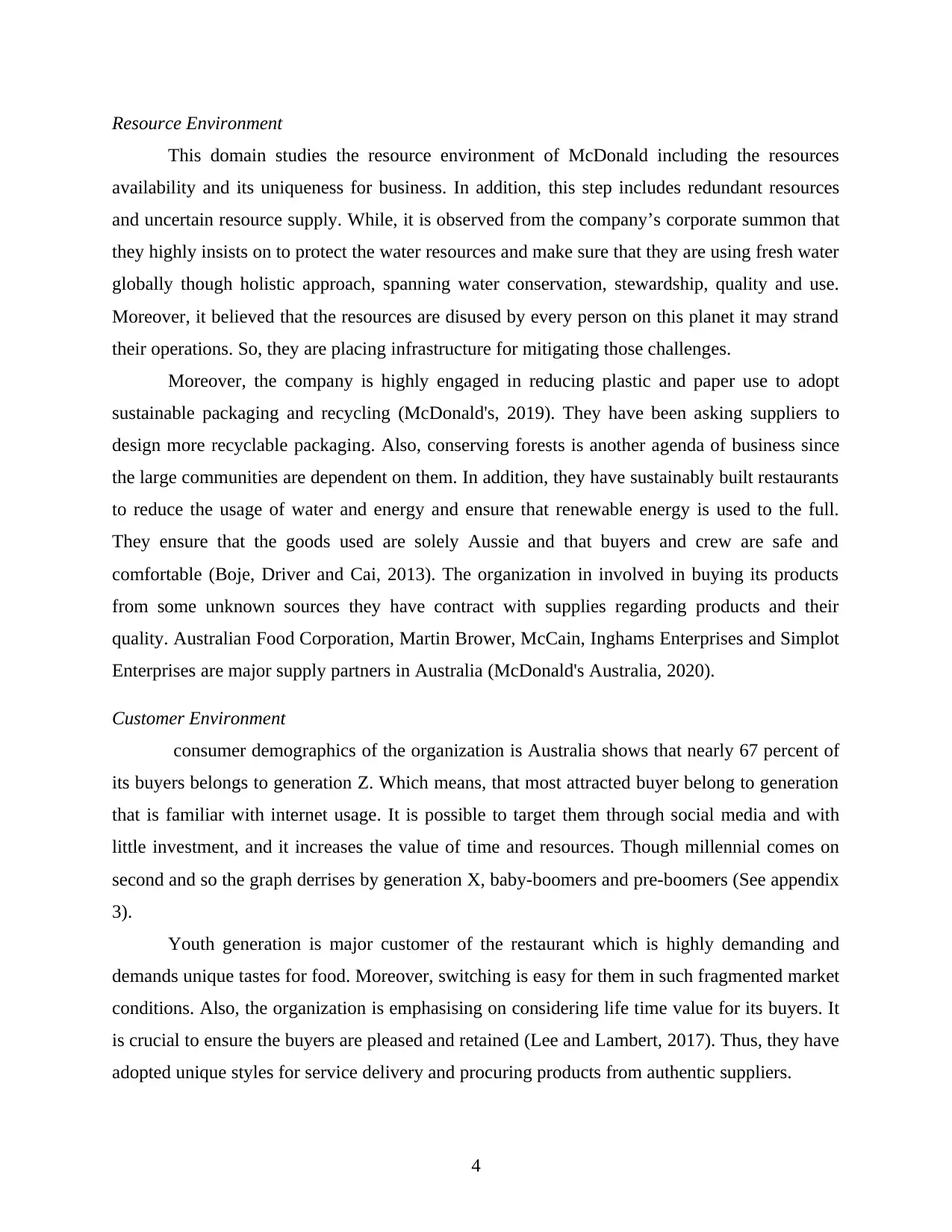
Resource Environment
This domain studies the resource environment of McDonald including the resources
availability and its uniqueness for business. In addition, this step includes redundant resources
and uncertain resource supply. While, it is observed from the company’s corporate summon that
they highly insists on to protect the water resources and make sure that they are using fresh water
globally though holistic approach, spanning water conservation, stewardship, quality and use.
Moreover, it believed that the resources are disused by every person on this planet it may strand
their operations. So, they are placing infrastructure for mitigating those challenges.
Moreover, the company is highly engaged in reducing plastic and paper use to adopt
sustainable packaging and recycling (McDonald's, 2019). They have been asking suppliers to
design more recyclable packaging. Also, conserving forests is another agenda of business since
the large communities are dependent on them. In addition, they have sustainably built restaurants
to reduce the usage of water and energy and ensure that renewable energy is used to the full.
They ensure that the goods used are solely Aussie and that buyers and crew are safe and
comfortable (Boje, Driver and Cai, 2013). The organization in involved in buying its products
from some unknown sources they have contract with supplies regarding products and their
quality. Australian Food Corporation, Martin Brower, McCain, Inghams Enterprises and Simplot
Enterprises are major supply partners in Australia (McDonald's Australia, 2020).
Customer Environment
consumer demographics of the organization is Australia shows that nearly 67 percent of
its buyers belongs to generation Z. Which means, that most attracted buyer belong to generation
that is familiar with internet usage. It is possible to target them through social media and with
little investment, and it increases the value of time and resources. Though millennial comes on
second and so the graph derrises by generation X, baby-boomers and pre-boomers (See appendix
3).
Youth generation is major customer of the restaurant which is highly demanding and
demands unique tastes for food. Moreover, switching is easy for them in such fragmented market
conditions. Also, the organization is emphasising on considering life time value for its buyers. It
is crucial to ensure the buyers are pleased and retained (Lee and Lambert, 2017). Thus, they have
adopted unique styles for service delivery and procuring products from authentic suppliers.
4
This domain studies the resource environment of McDonald including the resources
availability and its uniqueness for business. In addition, this step includes redundant resources
and uncertain resource supply. While, it is observed from the company’s corporate summon that
they highly insists on to protect the water resources and make sure that they are using fresh water
globally though holistic approach, spanning water conservation, stewardship, quality and use.
Moreover, it believed that the resources are disused by every person on this planet it may strand
their operations. So, they are placing infrastructure for mitigating those challenges.
Moreover, the company is highly engaged in reducing plastic and paper use to adopt
sustainable packaging and recycling (McDonald's, 2019). They have been asking suppliers to
design more recyclable packaging. Also, conserving forests is another agenda of business since
the large communities are dependent on them. In addition, they have sustainably built restaurants
to reduce the usage of water and energy and ensure that renewable energy is used to the full.
They ensure that the goods used are solely Aussie and that buyers and crew are safe and
comfortable (Boje, Driver and Cai, 2013). The organization in involved in buying its products
from some unknown sources they have contract with supplies regarding products and their
quality. Australian Food Corporation, Martin Brower, McCain, Inghams Enterprises and Simplot
Enterprises are major supply partners in Australia (McDonald's Australia, 2020).
Customer Environment
consumer demographics of the organization is Australia shows that nearly 67 percent of
its buyers belongs to generation Z. Which means, that most attracted buyer belong to generation
that is familiar with internet usage. It is possible to target them through social media and with
little investment, and it increases the value of time and resources. Though millennial comes on
second and so the graph derrises by generation X, baby-boomers and pre-boomers (See appendix
3).
Youth generation is major customer of the restaurant which is highly demanding and
demands unique tastes for food. Moreover, switching is easy for them in such fragmented market
conditions. Also, the organization is emphasising on considering life time value for its buyers. It
is crucial to ensure the buyers are pleased and retained (Lee and Lambert, 2017). Thus, they have
adopted unique styles for service delivery and procuring products from authentic suppliers.
4
Paraphrase This Document
Need a fresh take? Get an instant paraphrase of this document with our AI Paraphraser

But with the changing times Australia faces resource shortages and polluted water. Thus, crops
are not healthy and put a question on the store. To avoid the same they are working on removing
product obsolescence by mentioned initiatives. Also, the organization keeps their streets clean
around the restaurant through little patrol system, it is a daily activity performed by crew
members that picks litter from grounds (Ghobadian and O’Regan, 2014).
Legal and Regulatory Environment
The company has successfully expanded its business overseas. This comes with various
political and legal satiations from international borders. Although the Australian government has
developed requirements that make restaurants strictly obliged to produce food that is suitable and
safe to eat. Food Safety Act 1991, five food safety standards are mandatory standard for the
McDonalds.
Australian state and territorial government legislation is in place to protect customers, the
environment and the community. Also, they are accountable to assure that the competition and
trade is fair in the industry. The laws also regulate commercial contacts with other business
partners, customers, and suppliers (Campbell, 2019). Moreover, the government has also created
a standard framework for ensuring four trades in the country called Australian Competition and
Consumer Commission (ACCC).
Employment law safeguards the employers 'compensation system and the government
has rules for employees on minimum legal wages. The law has introductory level for workers
which has started working and is working from 3 months and after that they enter level 1 and so
on. Thus, there are different rates per hour different aged workers in Australia. The rates are not
fixed they are revised per year according to maker conditions (Tham and Fudge, 2018).
Employee benefits include staff pay entitlements, leave entitlements and record keeping. The
workers are paid for sick leaves, or day off with prior notice.
Global Environment
An organisation's global environment involves both controllable and uncontrollable
competition between international and domestic market activities. The market aspects influence
the resources utilization and capabilities as well. To manage this frequent changes the company
has develop real time communication system within organization to connect with customers
directly (Chung et.al., 2018). Thus, they have developed customised wireless food ordering
5
are not healthy and put a question on the store. To avoid the same they are working on removing
product obsolescence by mentioned initiatives. Also, the organization keeps their streets clean
around the restaurant through little patrol system, it is a daily activity performed by crew
members that picks litter from grounds (Ghobadian and O’Regan, 2014).
Legal and Regulatory Environment
The company has successfully expanded its business overseas. This comes with various
political and legal satiations from international borders. Although the Australian government has
developed requirements that make restaurants strictly obliged to produce food that is suitable and
safe to eat. Food Safety Act 1991, five food safety standards are mandatory standard for the
McDonalds.
Australian state and territorial government legislation is in place to protect customers, the
environment and the community. Also, they are accountable to assure that the competition and
trade is fair in the industry. The laws also regulate commercial contacts with other business
partners, customers, and suppliers (Campbell, 2019). Moreover, the government has also created
a standard framework for ensuring four trades in the country called Australian Competition and
Consumer Commission (ACCC).
Employment law safeguards the employers 'compensation system and the government
has rules for employees on minimum legal wages. The law has introductory level for workers
which has started working and is working from 3 months and after that they enter level 1 and so
on. Thus, there are different rates per hour different aged workers in Australia. The rates are not
fixed they are revised per year according to maker conditions (Tham and Fudge, 2018).
Employee benefits include staff pay entitlements, leave entitlements and record keeping. The
workers are paid for sick leaves, or day off with prior notice.
Global Environment
An organisation's global environment involves both controllable and uncontrollable
competition between international and domestic market activities. The market aspects influence
the resources utilization and capabilities as well. To manage this frequent changes the company
has develop real time communication system within organization to connect with customers
directly (Chung et.al., 2018). Thus, they have developed customised wireless food ordering
5
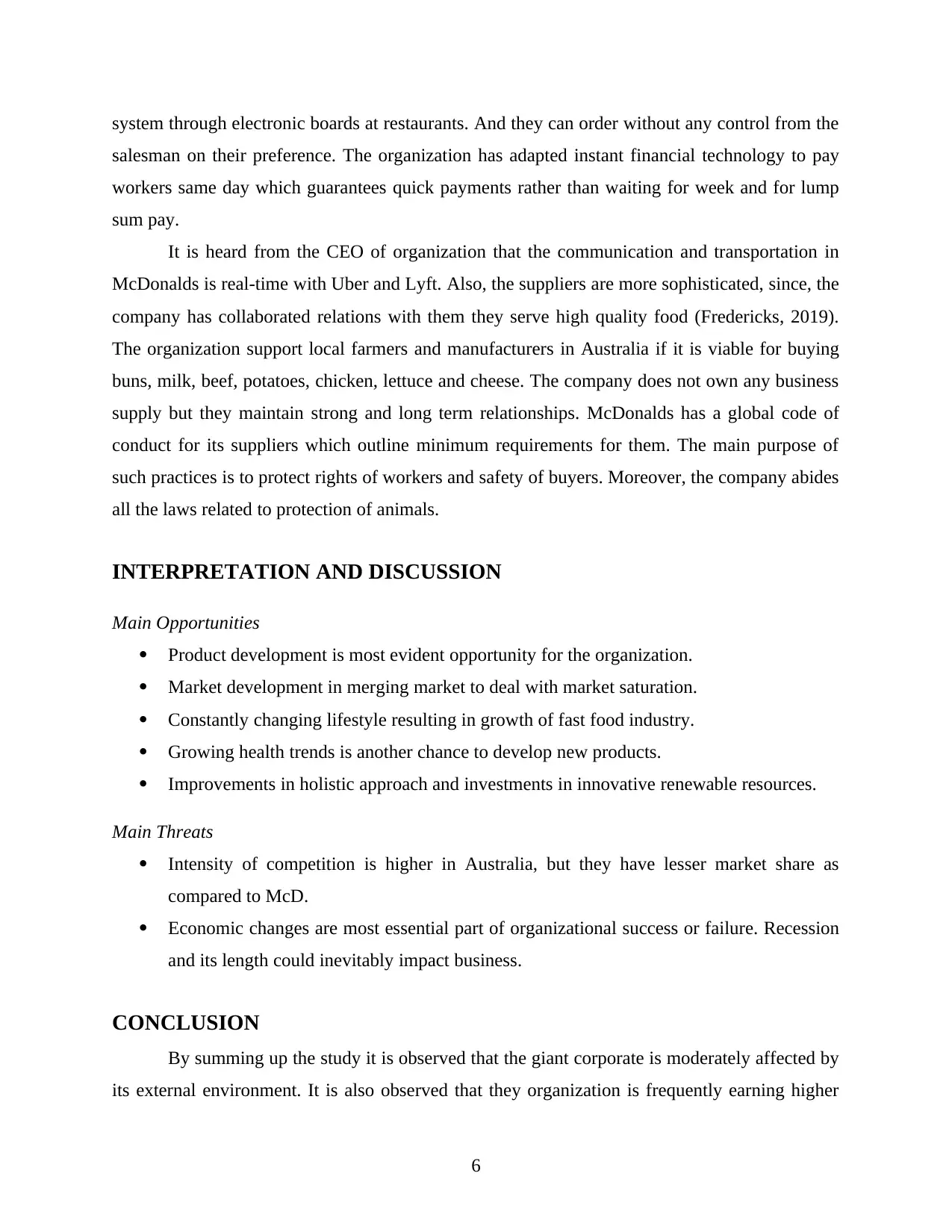
system through electronic boards at restaurants. And they can order without any control from the
salesman on their preference. The organization has adapted instant financial technology to pay
workers same day which guarantees quick payments rather than waiting for week and for lump
sum pay.
It is heard from the CEO of organization that the communication and transportation in
McDonalds is real-time with Uber and Lyft. Also, the suppliers are more sophisticated, since, the
company has collaborated relations with them they serve high quality food (Fredericks, 2019).
The organization support local farmers and manufacturers in Australia if it is viable for buying
buns, milk, beef, potatoes, chicken, lettuce and cheese. The company does not own any business
supply but they maintain strong and long term relationships. McDonalds has a global code of
conduct for its suppliers which outline minimum requirements for them. The main purpose of
such practices is to protect rights of workers and safety of buyers. Moreover, the company abides
all the laws related to protection of animals.
INTERPRETATION AND DISCUSSION
Main Opportunities
Product development is most evident opportunity for the organization.
Market development in merging market to deal with market saturation.
Constantly changing lifestyle resulting in growth of fast food industry.
Growing health trends is another chance to develop new products.
Improvements in holistic approach and investments in innovative renewable resources.
Main Threats
Intensity of competition is higher in Australia, but they have lesser market share as
compared to McD.
Economic changes are most essential part of organizational success or failure. Recession
and its length could inevitably impact business.
CONCLUSION
By summing up the study it is observed that the giant corporate is moderately affected by
its external environment. It is also observed that they organization is frequently earning higher
6
salesman on their preference. The organization has adapted instant financial technology to pay
workers same day which guarantees quick payments rather than waiting for week and for lump
sum pay.
It is heard from the CEO of organization that the communication and transportation in
McDonalds is real-time with Uber and Lyft. Also, the suppliers are more sophisticated, since, the
company has collaborated relations with them they serve high quality food (Fredericks, 2019).
The organization support local farmers and manufacturers in Australia if it is viable for buying
buns, milk, beef, potatoes, chicken, lettuce and cheese. The company does not own any business
supply but they maintain strong and long term relationships. McDonalds has a global code of
conduct for its suppliers which outline minimum requirements for them. The main purpose of
such practices is to protect rights of workers and safety of buyers. Moreover, the company abides
all the laws related to protection of animals.
INTERPRETATION AND DISCUSSION
Main Opportunities
Product development is most evident opportunity for the organization.
Market development in merging market to deal with market saturation.
Constantly changing lifestyle resulting in growth of fast food industry.
Growing health trends is another chance to develop new products.
Improvements in holistic approach and investments in innovative renewable resources.
Main Threats
Intensity of competition is higher in Australia, but they have lesser market share as
compared to McD.
Economic changes are most essential part of organizational success or failure. Recession
and its length could inevitably impact business.
CONCLUSION
By summing up the study it is observed that the giant corporate is moderately affected by
its external environment. It is also observed that they organization is frequently earning higher
6
⊘ This is a preview!⊘
Do you want full access?
Subscribe today to unlock all pages.

Trusted by 1+ million students worldwide
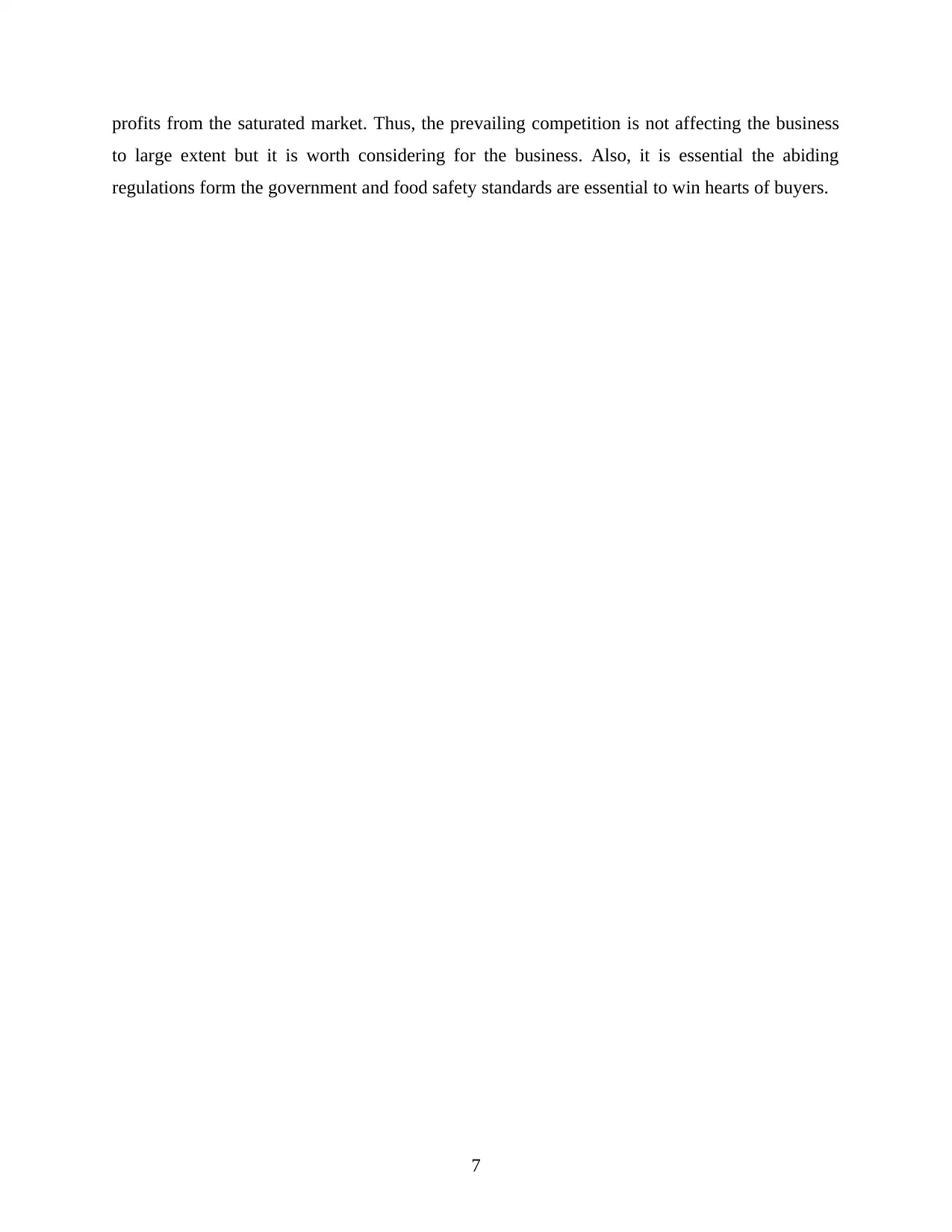
profits from the saturated market. Thus, the prevailing competition is not affecting the business
to large extent but it is worth considering for the business. Also, it is essential the abiding
regulations form the government and food safety standards are essential to win hearts of buyers.
7
to large extent but it is worth considering for the business. Also, it is essential the abiding
regulations form the government and food safety standards are essential to win hearts of buyers.
7
Paraphrase This Document
Need a fresh take? Get an instant paraphrase of this document with our AI Paraphraser
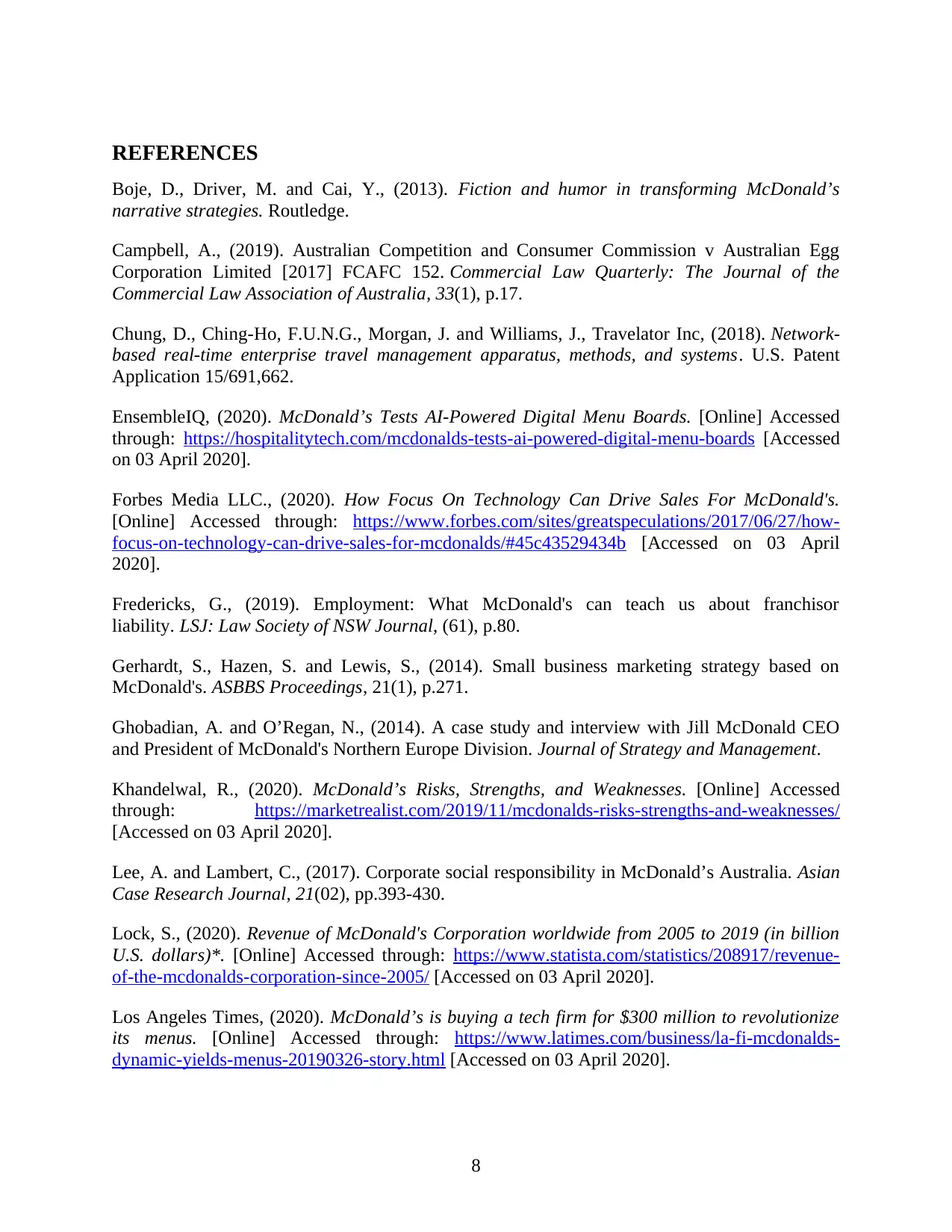
REFERENCES
Boje, D., Driver, M. and Cai, Y., (2013). Fiction and humor in transforming McDonald’s
narrative strategies. Routledge.
Campbell, A., (2019). Australian Competition and Consumer Commission v Australian Egg
Corporation Limited [2017] FCAFC 152. Commercial Law Quarterly: The Journal of the
Commercial Law Association of Australia, 33(1), p.17.
Chung, D., Ching-Ho, F.U.N.G., Morgan, J. and Williams, J., Travelator Inc, (2018). Network-
based real-time enterprise travel management apparatus, methods, and systems. U.S. Patent
Application 15/691,662.
EnsembleIQ, (2020). McDonald’s Tests AI-Powered Digital Menu Boards. [Online] Accessed
through: https://hospitalitytech.com/mcdonalds-tests-ai-powered-digital-menu-boards [Accessed
on 03 April 2020].
Forbes Media LLC., (2020). How Focus On Technology Can Drive Sales For McDonald's.
[Online] Accessed through: https://www.forbes.com/sites/greatspeculations/2017/06/27/how-
focus-on-technology-can-drive-sales-for-mcdonalds/#45c43529434b [Accessed on 03 April
2020].
Fredericks, G., (2019). Employment: What McDonald's can teach us about franchisor
liability. LSJ: Law Society of NSW Journal, (61), p.80.
Gerhardt, S., Hazen, S. and Lewis, S., (2014). Small business marketing strategy based on
McDonald's. ASBBS Proceedings, 21(1), p.271.
Ghobadian, A. and O’Regan, N., (2014). A case study and interview with Jill McDonald CEO
and President of McDonald's Northern Europe Division. Journal of Strategy and Management.
Khandelwal, R., (2020). McDonald’s Risks, Strengths, and Weaknesses. [Online] Accessed
through: https://marketrealist.com/2019/11/mcdonalds-risks-strengths-and-weaknesses/
[Accessed on 03 April 2020].
Lee, A. and Lambert, C., (2017). Corporate social responsibility in McDonald’s Australia. Asian
Case Research Journal, 21(02), pp.393-430.
Lock, S., (2020). Revenue of McDonald's Corporation worldwide from 2005 to 2019 (in billion
U.S. dollars)*. [Online] Accessed through: https://www.statista.com/statistics/208917/revenue-
of-the-mcdonalds-corporation-since-2005/ [Accessed on 03 April 2020].
Los Angeles Times, (2020). McDonald’s is buying a tech firm for $300 million to revolutionize
its menus. [Online] Accessed through: https://www.latimes.com/business/la-fi-mcdonalds-
dynamic-yields-menus-20190326-story.html [Accessed on 03 April 2020].
8
Boje, D., Driver, M. and Cai, Y., (2013). Fiction and humor in transforming McDonald’s
narrative strategies. Routledge.
Campbell, A., (2019). Australian Competition and Consumer Commission v Australian Egg
Corporation Limited [2017] FCAFC 152. Commercial Law Quarterly: The Journal of the
Commercial Law Association of Australia, 33(1), p.17.
Chung, D., Ching-Ho, F.U.N.G., Morgan, J. and Williams, J., Travelator Inc, (2018). Network-
based real-time enterprise travel management apparatus, methods, and systems. U.S. Patent
Application 15/691,662.
EnsembleIQ, (2020). McDonald’s Tests AI-Powered Digital Menu Boards. [Online] Accessed
through: https://hospitalitytech.com/mcdonalds-tests-ai-powered-digital-menu-boards [Accessed
on 03 April 2020].
Forbes Media LLC., (2020). How Focus On Technology Can Drive Sales For McDonald's.
[Online] Accessed through: https://www.forbes.com/sites/greatspeculations/2017/06/27/how-
focus-on-technology-can-drive-sales-for-mcdonalds/#45c43529434b [Accessed on 03 April
2020].
Fredericks, G., (2019). Employment: What McDonald's can teach us about franchisor
liability. LSJ: Law Society of NSW Journal, (61), p.80.
Gerhardt, S., Hazen, S. and Lewis, S., (2014). Small business marketing strategy based on
McDonald's. ASBBS Proceedings, 21(1), p.271.
Ghobadian, A. and O’Regan, N., (2014). A case study and interview with Jill McDonald CEO
and President of McDonald's Northern Europe Division. Journal of Strategy and Management.
Khandelwal, R., (2020). McDonald’s Risks, Strengths, and Weaknesses. [Online] Accessed
through: https://marketrealist.com/2019/11/mcdonalds-risks-strengths-and-weaknesses/
[Accessed on 03 April 2020].
Lee, A. and Lambert, C., (2017). Corporate social responsibility in McDonald’s Australia. Asian
Case Research Journal, 21(02), pp.393-430.
Lock, S., (2020). Revenue of McDonald's Corporation worldwide from 2005 to 2019 (in billion
U.S. dollars)*. [Online] Accessed through: https://www.statista.com/statistics/208917/revenue-
of-the-mcdonalds-corporation-since-2005/ [Accessed on 03 April 2020].
Los Angeles Times, (2020). McDonald’s is buying a tech firm for $300 million to revolutionize
its menus. [Online] Accessed through: https://www.latimes.com/business/la-fi-mcdonalds-
dynamic-yields-menus-20190326-story.html [Accessed on 03 April 2020].
8

McDonald's Australia, (2020). Meet the Suppliers. [Online] Accessed through:
https://mcdonalds.com.au/about-maccas/our-supply-chain/supply-partners [Accessed on 03 April
2020].
McDonald's, (2019). Our Planet. [Online] Accessed through:
https://corporate.mcdonalds.com/corpmcd/scale-for-good/our-planet.html [Accessed on 03 April
2020].
Olsen, H.M., Brown, W.J., Kolbe‐Alexander, T. and Burton, N.W., (2018). Physical activity and
sedentary behaviour in a flexible office‐based workplace: Employee perceptions and priorities
for change. Health Promotion Journal of Australia, 29(3), pp.344-352.
Roberts, J., (2018). Multinational business service firms: development of multinational
organization structures in the UK business service sector. Routledge.
Statista, (2020). Share of consumers who eat McDonald's in an average six months across
Australia as at March 2018, by generation. [Online] Accessed through:
https://www.statista.com/statistics/871626/australia-share-of-consumers-who-eat-mcdonalds-by-
generation/ [Accessed on 04 April 2020].
Tham, J.C. and Fudge, J., (2018). Unsavoury employer practices: Understanding temporary
migrant work in the Australian food services sector. International Journal of Comparative
Labour Law and Industrial Relations (Forthcoming).
9
https://mcdonalds.com.au/about-maccas/our-supply-chain/supply-partners [Accessed on 03 April
2020].
McDonald's, (2019). Our Planet. [Online] Accessed through:
https://corporate.mcdonalds.com/corpmcd/scale-for-good/our-planet.html [Accessed on 03 April
2020].
Olsen, H.M., Brown, W.J., Kolbe‐Alexander, T. and Burton, N.W., (2018). Physical activity and
sedentary behaviour in a flexible office‐based workplace: Employee perceptions and priorities
for change. Health Promotion Journal of Australia, 29(3), pp.344-352.
Roberts, J., (2018). Multinational business service firms: development of multinational
organization structures in the UK business service sector. Routledge.
Statista, (2020). Share of consumers who eat McDonald's in an average six months across
Australia as at March 2018, by generation. [Online] Accessed through:
https://www.statista.com/statistics/871626/australia-share-of-consumers-who-eat-mcdonalds-by-
generation/ [Accessed on 04 April 2020].
Tham, J.C. and Fudge, J., (2018). Unsavoury employer practices: Understanding temporary
migrant work in the Australian food services sector. International Journal of Comparative
Labour Law and Industrial Relations (Forthcoming).
9
⊘ This is a preview!⊘
Do you want full access?
Subscribe today to unlock all pages.

Trusted by 1+ million students worldwide
1 out of 14
Related Documents
Your All-in-One AI-Powered Toolkit for Academic Success.
+13062052269
info@desklib.com
Available 24*7 on WhatsApp / Email
![[object Object]](/_next/static/media/star-bottom.7253800d.svg)
Unlock your academic potential
Copyright © 2020–2026 A2Z Services. All Rights Reserved. Developed and managed by ZUCOL.





